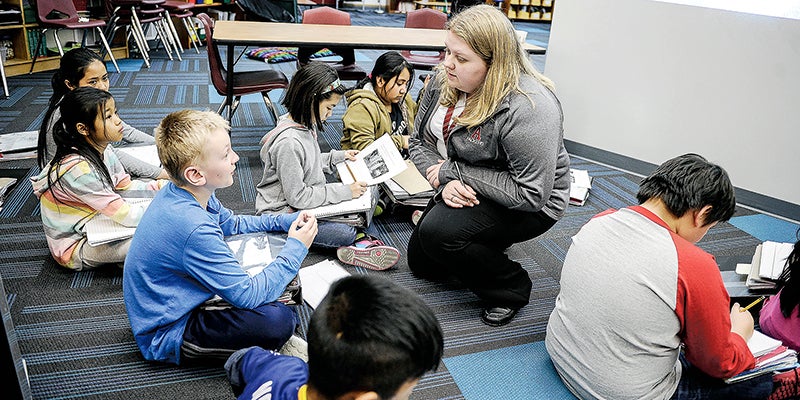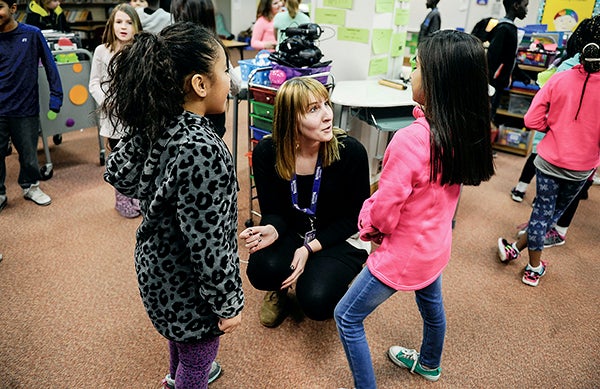Excitement growing for teacher prep program
Published 6:01 am Sunday, March 19, 2017

- Haley Sabin helps Sumner Elementary fourth-grader Levi Werner with a question during a project on the pros and cons of water desalination. Eric Johnson/photodesk@austindailyherald.com
As seen in the 2017 edition of Progress. Out now.
Years ago, Austin Superintendent Dave Krenz would receive a plentiful supply of applications when teaching positions opened.
At that time, the most difficult thing was figuring out how to shear down the number to a manageable size for interviews.
That’s not the case now. When the district advertised for a recent job opening at the elementary level, he received one application.
He’s not alone.
According to a recent study by the Learning Policy Institute, an education think tank, enrollment in teacher-preparation programs across the U.S. dropped from 691,000 in 2009 to 451,000 in 2014, a 35 percent decline.
A number of variables have come together to create the shortage, both in attraction to the profession and attrition among mid-career professionals. Modest pay is one.
A new generation of college students want to live in larger cities, leaving smaller communities, such as Austin, looking for new teachers.
Krenz knew that a partnership approach was needed — whose goal was “to grow our own” teaching pool.
And that was exactly what happened.
This spring, 24 new elementary teachers are headed to be the first graduation class of a new teacher prep program that partners Austin High School, Riverland Community College and Winona State University in a unique fashion. Another 10 are in the program’s junior class.
Krenz and staff invited Riverland and WSU to discuss a novel, new way of tackling the teacher shortage issue: Create an enhanced 2 + 2 elementary teacher education program tailored just for Austin.
The program would offer two years of study for a student’s associate degree at Riverland before transferring directly to WSU to complete a degree for a bachelor of science degree in teaching education.
While that concept is nothing new — many community and four-year colleges have similar agreements — this innovation is unique. All of the classes, clinical experiences and other training are done almost exclusively in Austin. The last two years are filled with clinicals and in-classroom training — a training many college students do not get until the spring of their senior year.
“I think, altogether, we’re supposed to have 160 hours of training in the classroom — but I know it’s even more than that,” said soon-to-be-a-graduate, Caitlin Haugland. “And we cannot believe how lucky we are to be part of this.”
Fellow student teacher Haley Sabin agreed.
“I love Austin,” she said. “I always wanted to be here. And hopefully, I will be hired here too.”
The classroom is located at Sumner Elementary School under the on-site guidance of Principal Sheila Berger; students will also participate in external clinicals that take them to other schools in the district, so that by the time each graduate, they will be have worked with at least six or seven other instructors. By the end of this year, the program’s seniors together will have worked with 45 different Austin teachers over their coursework, according to Dr. Debra Mishak, assistant professor from WSU who is also the coordinator of the 2+2 program. She is one instructor, and Matthew Weyers, a teacher on special assignment from Byron Public Schools, is the other.
Krenz said all his reports are positive.
“Our teachers seem to really enjoy working with these students and the students are enjoying the access they have to the classroom,” Krenz said.
Many in the pool are non-traditional students, primarily from Austin, or nearby. Some are paraprofessionals who already work in the classroom setting; others are mid-career students who have chosen to switch to education.
Mishak said she has one male student who had always wanted to go into education but, with six children, had to work at a better paying job in order to pay the bills.

Caitlin Haugland talks to third-graders Darlynn Rodriguez, left, and Brieana Gonzalez during a class project that required students to talk to each other asking nothing but questions. Eric Johnson/photodesk@austindailyherald.com
“But once his children were grown, his wife said, ‘Ok, it’s your turn,’ ” Mishak said.
He wasn’t sure he was young enough, but Mishak knows his maturity, experience and willingness are all pluses that older students sometimes overlook.
“And, as I told him, you’ve got 10, 15 years left to be in the classroom — of course we want you in our program,” Mishak said.
Some were concerned that they could not handle the time commitment, she said. As non-traditional students, many have full time jobs.
“So we work with them. We have a two- and three-year track [in the junior and senior years]; I said, if we need four years, we’ll do four,” she said.
Flexibility is an important factor in the program to help the students succeed. “Finding the time for coursework can be tough,” she said. “But we find ways to make it work,” she added.
Kelly McCalla, interim vice president of academic and student affairs at Riverland, says having three committed partners was a vital ingredient in the program’s formation.
“We had to agree upon responsibility; who was responsible to make it happen,” he said.
“The district had to say it was fine with people coming into the building,” and that is no small item, he added. “Security is a huge issue in schools, and letting our students come in takes a lot of trust” when you do not know the people.
Riverland also agreed to have three of its faculty teach three junior year classes, even though they were not, by rights, students at Riverland since they would have already obtained their associate’s degree.
“And the program had to be sustainable, that would still be in place 10 years from now,” McCalla said.
Both groups — administrators and students — have learned a lot from the experience, Mishak said.
Sabin, an Austin native and AHS graduate, is a senior in the program. She is just finishing her student teaching in fourth grade at Sumner Elementary School. Other teachers are placed in other schools, or in nearby districts.
“I was lucky; I love Sumner,” said Sabin, 24, adding that she also attended the school as a child.
She said her experience has been as rewarding as she had hoped. She transitioned from student to student teacher with little or no angst. By the time she stepped into her fourth-grade classroom, she had already had many hours in the elementary’s classrooms.
She and other fellow students participated in mock interviews with Austin school staff. The process gives them good experience, “and they (interview team) has a good exposure to us,” she said.
Haugland, 20, added the process has not been intimidating.
“College wasn’t this distant thing, just ‘out there,’” she said. “It’s in Austin where we went to [high] school. It felt comfortable.”
She first thought she wanted to be a psychologist, then she was able to shadow instructor Lisa Deyo at Southgate Elementary while still in high school.
“I knew immediately that it [teaching] was my calling,” Sabin said.
They admitted that their first time in front of a class was, as Haugland said, “scary.”
“Scary but fun,” stressed Sabin as they both laughed.
“I remember saying, ‘After this, we can do anything,’” Haugland added.
Both said they enjoyed the many opportunities to be “hands on” and the less expensive cost, since they could live at home.
Both urged others to consider the program.
“I would tell people, ‘go for it.’ The nice thing is that if you find you don’t like it, you can drop out during the first semester — and you haven’t spent a lot of time and money,” Haugland said.
But both said that the program is solid and they have learned much more than they anticipated.
While they know about policies, lesson plans and first days, they also know about finding patience when working with children, said Sabin.
And Haugland said she discovered “that you have to know your students as individuals; where they come from, what they think. Teaching is about building relationships with the kids.”
Both said they cannot wait for graduation. Both hope to stay in Austin, if they can.
“I’m so ready for my own classroom,” said Haugland. “I mean, so ready.”
Sabin agreed.
“We are definitely ready.”





